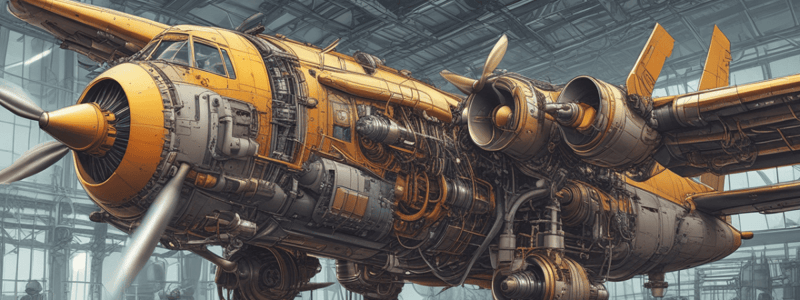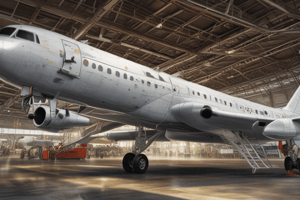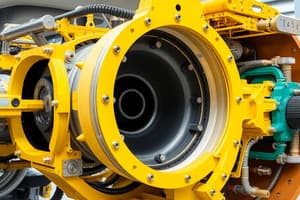Podcast
Questions and Answers
What is Pascal's law, and how does it relate to hydraulic systems?
What is Pascal's law, and how does it relate to hydraulic systems?
Pascal's law is a principle in fluid mechanics that states that pressure exerted anywhere in a confined incompressible fluid is transmitted equally in all directions throughout the fluid in such a way that the pressure variation is proportional to the applied force. In hydraulic systems, Pascal's law is used to amplify the pressure and force applied to a system, allowing for greater mechanical advantage.
What is the definition of mechanical advantage in a hydraulic system?
What is the definition of mechanical advantage in a hydraulic system?
The ratio of output force to the input force applied to a mechanism.
What is the advantage of using pistons of varying sizes in a hydraulic system?
What is the advantage of using pistons of varying sizes in a hydraulic system?
It allows for a large gain in mechanical advantage.
If a piston with an area of one square inch produces a pressure of one pound per square inch, what would be the force produced by a piston with an area of 20 square inches connected to the same system?
If a piston with an area of one square inch produces a pressure of one pound per square inch, what would be the force produced by a piston with an area of 20 square inches connected to the same system?
What is the relationship between the flow rate in gallons per minute and the pressure in pounds per square inch in a hydraulic system?
What is the relationship between the flow rate in gallons per minute and the pressure in pounds per square inch in a hydraulic system?
What happens to the one cubic inch of fluid displaced when the small piston moves down one inch, and how does it affect the movement of the large piston?
What happens to the one cubic inch of fluid displaced when the small piston moves down one inch, and how does it affect the movement of the large piston?
What is the purpose of a high pressure relief valve in a hydraulic system?
What is the purpose of a high pressure relief valve in a hydraulic system?
What is the function of an accumulator in a hydraulic system?
What is the function of an accumulator in a hydraulic system?
What is the purpose of a pressure gauge in a hydraulic system?
What is the purpose of a pressure gauge in a hydraulic system?
What are the three essential components of a basic hydraulic system?
What are the three essential components of a basic hydraulic system?
What is the primary difference between hydraulic systems and pneumatic systems, and how does this difference affect their applications?
What is the primary difference between hydraulic systems and pneumatic systems, and how does this difference affect their applications?
Describe the key components of a hydraulic system layout, and explain how they interact to transmit power.
Describe the key components of a hydraulic system layout, and explain how they interact to transmit power.
What are the characteristics of a well-designed hydraulic system, and how do these characteristics affect system performance?
What are the characteristics of a well-designed hydraulic system, and how do these characteristics affect system performance?
Explain how the electrical system interfaces with a hydraulic system, and describe the benefits of this interface.
Explain how the electrical system interfaces with a hydraulic system, and describe the benefits of this interface.
Describe the operation of a hydraulic system component, such as a piston, and explain how it contributes to the overall system function.
Describe the operation of a hydraulic system component, such as a piston, and explain how it contributes to the overall system function.
Flashcards are hidden until you start studying
Study Notes
Hydraulic Systems
- Open hydraulic systems, like rivers, can produce great amounts of power, but practical hydraulic systems are used to transmit power from one place to another.
- Engine-driven or electrically driven hydraulic pumps are used to move an incompressible fluid under pressure to actuators to perform tasks such as raising or lowering landing gear or flaps.
- Hydraulic systems are relatively lightweight and efficient, making them more desirable than electric or pneumatic systems.
Pascal's Law
- States that any increase in pressure on a confined liquid is transmitted equally and undiminished to all parts of the container.
- The increase in pressure acts at right angles to the enclosing walls of the container.
Definitions
- Force: energy exerted or brought to bear, and is the cause of motion or change, expressed in pounds or grams (g) or kilograms (kg).
- Pressure: a force applied over a given area, expressed in pounds per square inch (PSI) or grams per square centimetre (g/cm2).
Valves
- Pressure reducing valves are used to lower the normal system operating pressure to a specified amount to prevent over-loading some sub-systems.
- A pressure reducing valve schematic shows system pressure being ported to a sub-system through a shuttle and sleeve assembly.
Hydraulic Systems Introduction
- Hydraulic systems are used in aircraft to transmit power from one place to another.
- The system consists of components such as pumps, filters, accumulators, valves, actuators, and heat exchangers.
Hydraulic Flight Control Systems
- Hydraulic systems are used in aircraft flight control systems to perform tasks such as raising or lowering landing gear or flaps.
Maintenance and Safety
- Maintenance of regulators is crucial to ensure proper system operation.
- Quick disconnect couplings, pipe clamps, and other components require regular maintenance.
- Hydraulic system safety precautions include avoiding contamination, using proper procedures, and being aware of system limitations.
Pneumatic Systems
- Pneumatic systems have advantages and disadvantages compared to hydraulic systems.
- Pneumatic system components include compressors, air valves, and pneumatic actuators.
- Pneumatic systems are used in aircraft for tasks such as operating landing gear, brakes, and Doors.
Hydraulic Systems
- Practical hydraulic systems are used to transmit power from one place to another, not to generate power.
- In modern aircraft, hydraulic systems are used to move an incompressible fluid under pressure to actuators to perform various tasks.
Pascal's Law
- Pascal's Law states that any increase in pressure on a confined liquid is transmitted equally and undiminished to all parts of the container.
- The law acts at right angles to the enclosing walls of the container.
Definitions
- Force: energy exerted or brought to bear, causing motion or change; expressed in pounds, grams, or kilograms.
- Pressure: force applied over a given area; expressed in pounds per square inch (PSI) or grams per square centimeter (g/cm2).
- Distance: movement of an object; expressed in feet (Ft) or meters (M).
- Work: done when a force causes an object to move; calculated by multiplying force and distance; expressed in foot-pounds (lb/f) or kilogram-meters (kg/m).
- Power: rate of doing work; calculated by dividing work by time; expressed in horsepower (hp).
Hydraulic System Calculations
- Power calculation: Power = Force × Distance ÷ Time
- Hydraulic power calculation: Power = Gallons per minute × Pounds per square inch × 0.000583
Mechanical Advantage
- Mechanical advantage: ratio of output force to input force applied to a mechanism.
- Advantages of hydraulic systems: ease of transmitting force over large distances and into sealed compartments, and large gain in mechanical advantage through varying piston sizes.
- Mechanical advantage in hydraulic systems: achieved by increasing the area of the output piston, resulting in a greater force being produced.
Hydraulic Systems
- Hydraulic systems consist of essential components that are necessary for system operation, including reservoir, pump, valves, filter, accumulator, heat exchanger, and actuators.
- Figure 3 shows a basic hydraulic system where the engine-driven or hand pump draws hydraulic fluid from the reservoir, boosting pressure to system requirements.
Reservoir
- The reservoir is a tank that stores an adequate supply of fluid for the system.
- Fluid flows from the reservoir to the pumps, where it is forced through the system, and eventually returns to the reservoir.
- The reservoir replenishes fluid lost through leakage, serves as an overflow basin for excess fluid, and allows fluid to purge itself of air bubbles.
Components
- Pumps:
- Draw hydraulic fluid from the reservoir
- Boost pressure to system requirements
- Valves:
- Control the flow of fluid to the actuating cylinder
- Provide a path for fluid to return to the reservoir
- Filter:
- Filters the fluid before it returns to the reservoir
- Accumulator:
- Supplies a limited amount of hydraulic fluid under pressure to run the system
- Dampens pulsating pressures generated by the pump output
- Heat Exchanger:
- Not explicitly described in the text
Actuators
- Actuating cylinder:
- Moves in response to fluid flow controlled by the selector valve
- Can cause movement in a flight control system
Pascals Law and Mechanical Advantage
- Not explicitly described in the text, but mentioned as assessment criteria
Hydraulic Systems in Aircraft
- Hydraulic systems are used in a wide variety of applications in aircraft, including landing gear and flight control systems.
- They belong to the branch of physics known as fluid power systems, which use incompressible fluids to generate, control, and transmit power.
History of Fluid Power
- The earliest application of fluid power was moving objects by floating them down streams on rafts or barges.
- Later, water wheels were used to power industrial plants, and today, water-driven high-speed turbines generate electricity in hydroelectric power plants.
Basic Hydraulic System Components
- A hydraulic system consists of essential components, including a reservoir, pump, valves, filter, accumulator, heat exchanger, and actuators.
Reservoir
- A reservoir is a tank that stores an adequate supply of hydraulic fluid for the system.
- It supplies fluid to the pumps, which is then forced through the system, and eventually returns to the reservoir.
- The reservoir also replenishes fluid lost through leakage and serves as an overflow basin for excess fluid.
Pump
- A pump draws hydraulic fluid from the reservoir and boosts the pressure to the system requirements.
Valves
- Check valves and selector valves are used to direct the flow of fluid to the actuating cylinder.
- The selector valve controls the flow of fluid to the actuating cylinder and provides a path for the fluid to return to the reservoir.
Actuating Cylinder
- The actuating cylinder is controlled by the selector valve, which directs fluid to the cylinder, causing it to move.
- The selector valve also provides a path for the fluid to return to the reservoir.
Accumulator
- An accumulator supplies a limited amount of hydraulic fluid under pressure to run the system in case of an engine or pump failure.
- It also dampens any pulsating pressures generated by the pump output.
Hydraulic System Operation
- Hydraulic fluid is drawn from the reservoir by the pump, which boosts the pressure to the system requirements.
- The fluid travels through various check valves and is directed to the selector valve, which controls the flow of fluid to the actuating cylinder.
- The actuating cylinder is controlled by the selector valve, causing it to move.
Studying That Suits You
Use AI to generate personalized quizzes and flashcards to suit your learning preferences.



